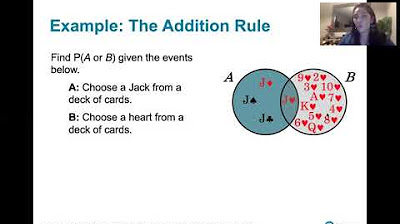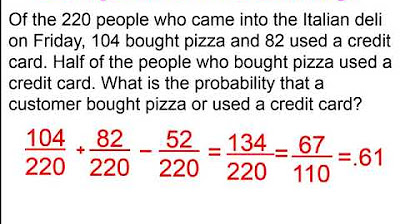4.2.5.1 Addition and Multiplication Rules - The Rationale Behind the Multiplication Rule
TLDRThis video script explains the multiplication rule for calculating the probability of two events, A and B, occurring together. It uses a true-false and a multiple-choice question scenario to illustrate the concept. The presenter demonstrates how to determine the sample space and calculate the probability of both questions being answered correctly. The script clarifies that the multiplication rule is not just a formula but an intuitive approach, showing that the probability of A and B happening is the product of their individual probabilities, assuming A has already occurred. The explanation aims to make viewers comfortable with the rule and its application.
Takeaways
- 🔢 The multiplication rule states that the probability of both events A and B occurring is the product of the probability of A and the probability of B given that A has already occurred.
- 🔄 To understand the multiplication rule, we can use examples involving basic probability scenarios.
- 📊 In the example of a true/false question and a multiple-choice question with five options, the sample space includes all possible answer combinations.
- 🧮 The sample space for answering a true/false question and a multiple-choice question is 10, as there are 2 options for the true/false and 5 for the multiple-choice question.
- 🧩 To find the probability of answering both questions correctly, we consider the number of ways to get the correct answers out of the total possibilities.
- ✅ For the true/false question, the probability of getting the correct answer is 1/2.
- 🎲 For the multiple-choice question, the probability of getting the correct answer is 1/5.
- 🔗 The multiplication rule can be applied by multiplying these probabilities: 1/2 * 1/5 = 1/10, which matches the result from counting the sample space.
- 📖 The multiplication rule is also called the formulaic or algebraic approach, as it uses symbols to represent probabilities.
- 🔍 This rule can be seen as intuitive by considering the number of possible outcomes in combined events and their respective sample spaces.
Q & A
What is the multiplication rule in probability?
-The multiplication rule states that to find the probability of two events A and B occurring together, you multiply the probability of event A by the probability of event B, assuming that event A has already occurred.
Why is the multiplication rule important in probability calculations?
-The multiplication rule is important because it helps in calculating the joint probability of two events, which is essential for understanding the likelihood of multiple events happening simultaneously.
Can you give an example of how the multiplication rule is applied in the script?
-In the script, the example given is about finding the probability of correctly answering both a true/false question and a multiple-choice question with five options. The multiplication rule is used to calculate the probability of both questions being answered correctly.
What is the sample space in the context of the true/false and multiple-choice questions example?
-The sample space includes all possible outcomes of answering the true/false question (true or false) and then the multiple-choice question (options A, B, C, D, E), resulting in 10 possible outcomes.
How many correct outcomes are there for both questions to be answered correctly in the example?
-There is only one correct outcome where both the true/false question and the multiple-choice question are answered correctly.
What is the probability of answering the first question (true/false) correctly?
-The probability of answering the first question correctly is 1 out of 2, as there are two options (true or false) and only one is correct.
What is the probability of answering the second question (multiple-choice) correctly, given only one correct answer?
-The probability of answering the second question correctly is 1 out of 5, as there are five options and only one is correct.
How does the multiplication rule confirm the probability of both questions being answered correctly?
-By multiplying the probability of the first question being correct (1/2) by the probability of the second question being correct (1/5), the result is 1/10, which matches the probability calculated using the sample space method.
What does the script suggest about the relationship between the multiplication rule and the number of elements in sample spaces?
-The script suggests that the multiplication rule is consistent with the number of elements in the sample spaces. The total number of outcomes (10) is the product of the number of outcomes for each event (2 for the first question and 5 for the second question).
Is the script providing a proof for the multiplication rule?
-No, the script is not providing a formal proof but rather an intuitive explanation and an example to help the viewer understand why the multiplication rule works.
How does the script define event A and event B in the context of the example?
-In the context of the example, event A is getting the first question (true/false) correct, and event B is getting the second question (multiple-choice) correct.
Outlines
🧠 Understanding the Multiplication Rule for Probability
The video script begins by introducing the multiplication rule for calculating the probability of two events, A and B, occurring together. It explains that the rule involves multiplying the probability of A by the probability of B, given that A has already occurred. To clarify this concept, an example is provided involving a true/false question and a multiple-choice question with five options. The script outlines the process of creating a sample space for these two questions and demonstrates how to calculate the probability of both questions being answered correctly using the sample space and the multiplication rule. It concludes by emphasizing that the multiplication rule is based on the number of elements in the sample spaces and is not just a formula but a conceptual approach to understanding probabilities.
📚 Applying the Multiplication Rule with Sample Space Analysis
In the second paragraph, the script delves deeper into the multiplication rule by applying it to the example provided. It explains how to determine the probability of correctly answering a true/false question and a multiple-choice question. The script breaks down the sample space for each question, identifying the correct and incorrect options, and then uses these to calculate the probability of both questions being answered correctly. The explanation shows that the multiplication of the individual probabilities of each correct answer (1/2 for the true/false and 1/5 for the multiple-choice) results in the overall probability of 1/10. The script reinforces the idea that the multiplication rule is a reflection of the number of outcomes in the sample spaces and concludes by encouraging viewers not to be intimidated by the formulaic representation of the rule, as it is a symbolic representation of the conceptual approach discussed earlier.
Mindmap
Keywords
💡Multiplication Rule
💡Probability
💡Sample Space
💡Event A and Event B
💡True/False Question
💡Multiple Choice Question
💡Independence
💡Algebraic Approach
💡Formulaic Approach
💡Intuitive Approach
💡Denominator
Highlights
The multiplication rule is introduced for calculating the probability of two events, A and B, occurring together.
The rule states that the probability of A and B is the probability of A multiplied by the probability of B given A has already occurred.
An example is given using a true/false question and a multiple-choice question to illustrate the rule.
The sample space for the example includes all combinations of the true/false answer and the multiple-choice options.
The total number of possibilities in the sample space is 10, with only one correct combination for both questions.
The probability of getting both questions correct is calculated using the sample space.
Event A is defined as getting the first question correct, and event B is getting the second question correct.
The probability of answering the first question correctly is one out of two.
The probability of answering the second question correctly is one out of five, given one correct answer among five options.
The multiplication of the probabilities of the first and second questions results in the same probability as using the sample space method.
The multiplication rule is explained in terms of the number of elements in the sample spaces for each event.
The total number of options is the product of the options in the sample spaces of both events.
The video suggests that the multiplication rule is not just a formula but a representation of the relationship between the probabilities of events.
The formulaic or algebraic approach is presented as a symbolic way to express the multiplication rule.
The video emphasizes not to be intimidated by the symbols, as they represent the underlying concept of the rule.
The multiplication rule is illustrated as a fundamental principle in understanding the joint probability of events.
The video concludes by reinforcing the practicality and intuitiveness of the multiplication rule in probability calculations.
Transcripts
Browse More Related Video

Multiplication & Addition Rule - Probability - Mutually Exclusive & Independent Events

4.2.2 Addition and Multiplication Rules - The Addition Rule

Elementary Stats Lesson #8

Conditional Probability With Venn Diagrams & Contingency Tables

4.2.1 Addition and Multiplication Rules - Simple and Compound Events, and Their Probabilities

Chapter 4 Probability Part 2
5.0 / 5 (0 votes)
Thanks for rating: